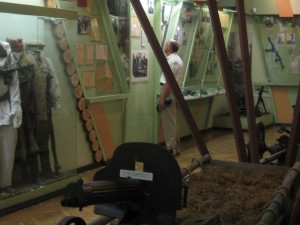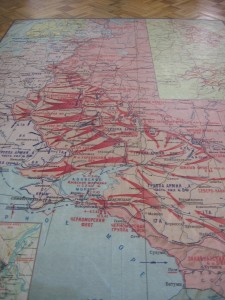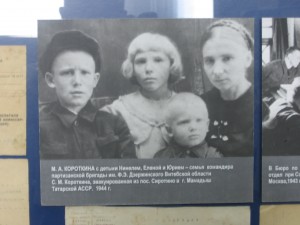Friday, July 3, is Independence Day in Belarus.??? We attempted to see the parade of tanks and other military vehicles and to hear Alexander Lukashenko, the president of Belarus.?? However, we were turned back at a security checkpoint because of my knapsack.?? I realized that, while Belarus women carry small purses, the men rarely carry anything.
So we went to the Belarusian State Museum of the Great Patriotic War on Nyezhavizhimosty Avenue.? The Great Patriotic War is the Eastern front of WWII, and this calamitous event is still very much alive in the memory of Belarus people.?? But first, a little background, borrowed in part from the excellent guidebook on Belarus, written by Nigel Roberts, published by Bradt.
Germany voided the Molotov-Ribbentrop Pact of Non-Aggression by invading the Soviet Union at the Polish-Belarus border among other places on June 22, 1941 under Operation Barbarossa.?? The attack on Minsk comprised of aerial bombardment by blitzkrieg and the Second and Third Panzer tank groups.?? Six days after the border was crossed, Minsk was taken.?? Stalin?s policy was to buy time by falling back to the defence of Moscow, taking plant and machinery from factories, thousands of people from the civilian population, and museum and gallery artifacts, back to the east.
The Nazis regarded both Jews and Slavs as subhuman, which permitted them to be treated as animals. The local population was pressed into slave labor, and the public parks were the sites of mass hanging.?? Jews had been the third largest ethnic group in Belarus.?? The population of the largest Belarus cities at the time of the invasion was over 50% Jewish.?? Some 800,000 Jews, 90% of the Jewish population in Belarus, were killed during the Holocaust.
Slavs were also subhuman in Nazi eyes, and starvation was a Nazi strategy. Generalplan Ost (east) was part of Hitler?s Lebensraum (living space) plan, and fulfilled the Drang nach Osten (Drive to the East) ideology.?? Under Generalplan Ost, Belarus, Poland, Ukraine and other areas would be ethically cleansed, and the land opened up for German colonizers.?? Pieces of this plan were implemented through death camps and enslavement.?? At the same time Soviet and Belarus partisan resistance grew and harassed the occupying German army.?? The response of the Nazis to partisan attack was often the burning of the local village with its inhabitants.??? On July 3, 1944, having defeated Operation Barbarossa and then launched their own offensives, the Soviet Red Army arrived in Minsk.?? The destruction of the city was almost total.?? Most of the houses, factories, and administrative buildings had been flattened, while road, rail and bride infrastructure had been bombed.?? A city of 300,000 civilians in 1939 now had 50,000 people.
The Belarussian State Museum of the Great Patriotic War chronicles the terrible events of WWII, and documents the famous Belarusian partisan movement that undermined the occupation.?? I discovered that one of? my colleagues at Simmons had been to this museum 20 years ago on a guided tour, and as the guide went through the museum, apparently for the first time, she wept.
My guide, Piotr Lapo, explained the differences in the weapons, and their effectiveness in stopping tanks.?? I was struck by the somber faces in the black and white photographs of the fighters, partisans, and civilians, all of whom stared out of the exhibit walls with similar, penetrating gazes.



